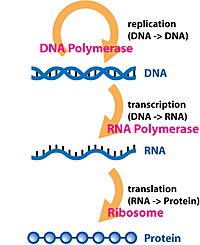

In molecular genetics, the three prime untranslated region (3′-UTR) is the section of messenger RNA (mRNA) that immediately follows the translation termination codon. The 3′-UTR often contains regulatory regions that post-transcriptionally influence gene expression.
During gene expression, an mRNA molecule is transcribed from the DNA sequence and is later translated into a protein. Several regions of the mRNA molecule are not translated into a protein including the 5' cap, 5' untranslated region, 3′ untranslated region and poly(A) tail. Regulatory regions within the 3′-untranslated region can influence polyadenylation, translation efficiency, localization, and stability of the mRNA.[1][2] The 3′-UTR contains binding sites for both regulatory proteins and microRNAs (miRNAs). By binding to specific sites within the 3′-UTR, miRNAs can decrease gene expression of various mRNAs by either inhibiting translation or directly causing degradation of the transcript. The 3′-UTR also has silencer regions which bind to repressor proteins and will inhibit the expression of the mRNA.
Many 3′-UTRs also contain AU-rich elements (AREs). Proteins bind AREs to affect the stability or decay rate of transcripts in a localized manner or affect translation initiation. Furthermore, the 3′-UTR contains the sequence AAUAAA that directs addition of several hundred adenine residues called the poly(A) tail to the end of the mRNA transcript. Poly(A) binding protein (PABP) binds to this tail, contributing to regulation of mRNA translation, stability, and export. For example, poly(A) tail bound PABP interacts with proteins associated with the 5' end of the transcript, causing a circularization of the mRNA that promotes translation.
The 3′-UTR can also contain sequences that attract proteins to associate the mRNA with the cytoskeleton, transport it to or from the cell nucleus, or perform other types of localization. In addition to sequences within the 3′-UTR, the physical characteristics of the region, including its length and secondary structure, contribute to translation regulation. These diverse mechanisms of gene regulation ensure that the correct genes are expressed in the correct cells at the appropriate times.
- ^ Barrett, Lucy W.; Fletcher, Sue; Wilton, Steve D. (27 April 2012). "Regulation of eukaryotic gene expression by the untranslated gene regions and other non-coding elements". Cellular and Molecular Life Sciences. 69 (21): 3613–3634. doi:10.1007/s00018-012-0990-9. PMC 3474909. PMID 22538991.
- ^ Pichon, Xavier; A. Wilson, Lindsay; Stoneley, Mark; Bastide, Amandine; A King, Helen; Somers, Joanna; E Willis, Anne (1 July 2012). "RNA Binding Protein/RNA Element Interactions and the Control of Translation". Current Protein & Peptide Science. 13 (4): 294–304. doi:10.2174/138920312801619475. PMC 3431537. PMID 22708490.